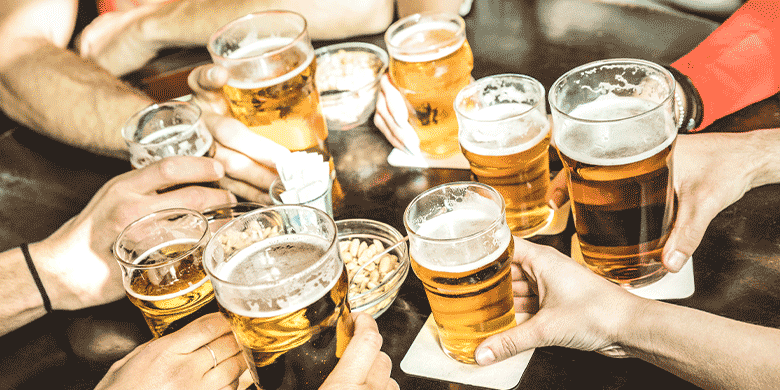
24 July, 2023
The Secret Of Perfect Beer: Exploring the World of Nucleated Glasses
Nucleated beer glasses are specifically designed glassware that enhances the appearance and flavour of carbonated beverages, particularly beer. These glasses feature laser-etched or etched patterns at the bottom, known as nucleation sites, which promote the formation of bubbles and maintain a steady release of carbon dioxide (CO2) from the beverage.
The nucleation sites in beer glasses serve as rough surfaces where microscopic gas pockets can form. These irregularities disrupt the smooth surface tension of the liquid, providing nucleation points for the release of CO2 bubbles. The laser-etched patterns or etched designs create a matrix of tiny points, ensuring a controlled and consistent release of bubbles throughout the glass.
The presence of nucleation sites in the glass plays a crucial role in enhancing the visual appeal of beer. As the bubbles rise from the nucleation sites, they create a steady stream of effervescence and a cascade of carbonation throughout the liquid. This effervescence results in a vibrant and lively appearance, with a frothy head forming on top of the beer.
From a technical standpoint, nucleated beer glasses can significantly impact the overall drinking experience. The controlled release of CO2 bubbles enhances the visual presentation and affects the aroma and flavour of the beer. The rising bubbles help to release volatile aromatic compounds, allowing the drinker to fully appreciate the beer's bouquet. The effervescence also provides a more balanced and crisp mouthfeel, enhancing the perception of carbonation and freshness.
In terms of design and manufacturing, nucleated beer glasses require precision etching techniques. It involves several technical steps to create the desired nucleation pattern on the glass surface. Here is a detailed explanation of the typical manufacturing process:
- Glass selection: The first step is to select a suitable glass material for manufacturing the nucleated beer glasses. The glass should be transparent, durable, and able to withstand the production process and regular use.
- Designing the nucleation pattern: The next step is to design the specific nucleation pattern that will be etched onto the glass surface. This pattern should include a matrix of tiny points or rough surfaces to serve as nucleation sites. The design may vary depending on the desired density of nucleation sites, the beer style the glass is intended for, and other design considerations.
- Preparing the glass blanks: Glass blanks, which are essentially the initial pieces of glassware, are prepared by cutting or moulding the glass into the desired shape. This can involve techniques such as blowing or pressing the glass into moulds to form the basic glassware shape, such as a pint glass or a tulip glass.
- Laser etching or etching process: The nucleation pattern is then etched onto the glass surface. There are two common methods for achieving this: laser etching and chemical etching.
- Laser etching: In laser etching, a high-powered laser is used to remove tiny portions of the glass surface, creating the desired nucleation pattern. The laser removes material in a controlled manner, following the predetermined design. This precise process ensures that the nucleation sites are evenly distributed across the glass surface.
- Chemical etching: Chemical etching involves using a chemical solution to etch the glass and create the nucleation pattern. The solution selectively removes material from the glass surface, leaving behind the desired roughness and nucleation sites. This method can be cost-effective for large-scale production but requires careful control of the etching process to achieve consistent results.
It's important to note that the exact manufacturing process may vary depending on the specific techniques and equipment used by different glass manufacturers. However, the overall goal remains the same: to create nucleated beer glasses with a precise and consistent nucleation pattern that enhances the appearance, aroma, and flavour of beer.
Types Of Nucleated Beer Glasses
Various styles of nucleated beer glasses are available, each designed to enhance the drinking experience of specific beer styles. Here are some common styles:
- Nucleated Pint Glass: This is the classic and most widely recognised style of nucleated beer glass. It features a nucleation pattern at the bottom to promote bubble release and maintain carbonation. The shape of the glass is typically cylindrical with a slight taper towards the top, allowing for a frothy head to form.
- Nucleated Tulip Glass: The tulip glass is known for its bulbous body, flared rim, and nucleation pattern at the base. It is commonly used for aromatic beers, such as Belgian ales or IPAs, as the shape helps capture and concentrate the beer's aromas.
- Nucleated Snifter Glass: Snifter glasses have a short stem, wide bowl, and nucleation sites at the bottom. They are often used for strong, aromatic beers like stouts and barley wines. The nucleation pattern helps release the beer's aromas, while the bowl shape allows for swirling and capturing the aromatics.
- Nucleated Weizen Glass: Weizen glasses are specifically designed for wheat beers like hefeweizens. These glasses typically have a tall, slender shape with a nucleation pattern at the base. The tall shape helps maintain a foamy head and allows for the appreciation of the beer's colour and carbonation.
- Nucleated Lager Glass: Lager glasses are designed to showcase the clarity and effervescence of lagers. They often feature a nucleation pattern at the bottom and have a slightly tapered shape that widens towards the top. The nucleation sites help release bubbles, enhancing the beer's appearance and carbonation.
- Nucleated IPA Glass: IPA glasses are specifically tailored to accentuate the flavours and aromas of India Pale Ales. These glasses typically have a nucleation pattern at the base and a slender shape that helps concentrate the hop aromas towards the nose.
- Nucleated Stemmed Glass: Stemmed glasses, such as goblets or chalices, can also be nucleated to enhance the beer-drinking experience. These glasses typically have a nucleation pattern at the bottom and a stem for holding. They are often used for specialty or high-alcohol beers.
These are just a few examples of nucleated beer glass styles, and there are many more available to suit different beer styles and preferences. The specific design and shape of the glass, combined with the nucleation pattern, contribute to the optimal enjoyment of the beer's appearance, aroma, and flavour.
In summary, nucleated beer glasses are a technical innovation in glassware that enhances the appearance, aroma, and flavour of carbonated beverages, particularly beer. Through precision etching techniques and strategically placed nucleation sites, these glasses provide a controlled release of bubbles, resulting in a visually appealing beer with improved aroma and mouthfeel.
The Glassware Only Team



